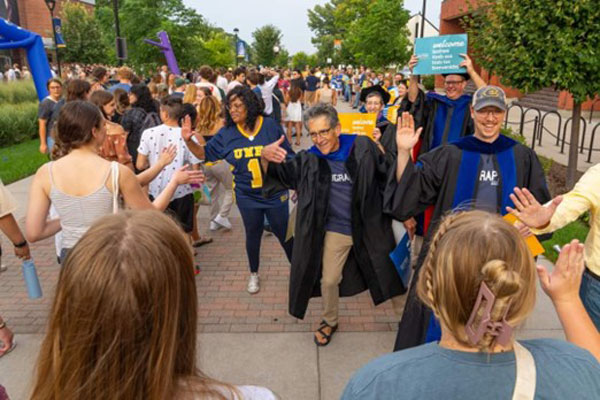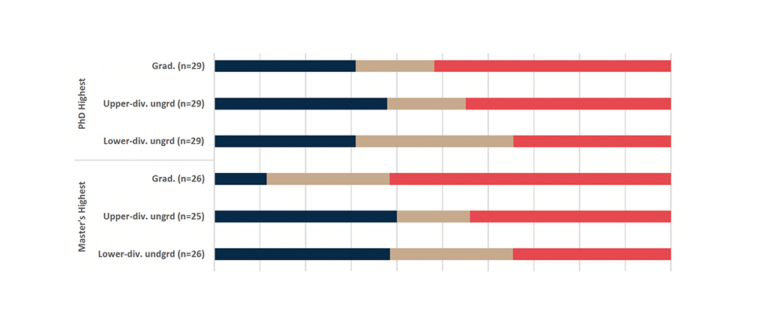The Not-So-Silent Majority
The numbers are staggering: the majority (according to the AAUP, 56 percent) of academics teaching in American universities and colleges are contingent faculty, defined as either full-time non-tenure-track (NTT) or part-time faculty; adding graduate student teachers into the mix increases the percentage to 76 percent. The impact on higher education and on peoples’ lives is also staggering. Most people employed in the academic labor force are living precarious lives, and the fate of higher education might very well dangle in the balance. Even the U.S. House of Representatives has weighed in, recently filing a committee report whose conclusion minces no words “In today’s lean era, schools have often chosen to balance their budgets on the backs of adjuncts.”¹ In order to better hear what the not-so-silent majority is telling us, I asked AAG council members to discuss with their colleagues and reflect on the impact of contingency within geography, and we had a robust conversation about this at our Fall council meeting (contingency was also the subject of one of Ken Foote’s presidential columns). In this column I review what we know and don’t know about contingency within Geography, summarize the points made at the council meeting, and present some ideas (most of which are not my own!) of what the AAG and the discipline might do to ameliorate some of the negative impacts of contingency. I also add my own voice to the stories of the not-so-silent majority.

Although we know that the number of contingent faculty teaching in higher education in general has been rising since at least 1975, we have very little data about contingency within geography per se (although we are hoping to conduct a survey in the near future that would include questions about contingency). Two very good recent surveys of contingent faculty in the U.S. provide some contours of the situation. We know that there are more part-timers teaching in the humanities than in the social sciences or sciences. According to the Coalition on the Academic Workforce’s recent survey² (more than 10,000 part-time faculty members responded to this 2010 survey), 42 percent of part-time faculty teaching in universities and colleges were in the humanities, compared to 13.8 percent in the social sciences and 14 percent in the sciences (the rest are teaching in professional or “other” fields). And we know that women make up a disproportionate percentage of contingent faculty. The AAUP’s survey of all instructional types indicates that more women than men are part-time or NTT faculty; the data are not as clear-cut in terms of race and ethnicity. We also know from these surveys that by far the majority of contingent faculty (almost 75 percent) are “waiting” for a tenure-track job, i.e. contingency is not a choice for most but considered a step along the tenured career path. The executive summary of the part-time faculty report was sobering: the average pay per course was $2,700, faculty rarely received professional support outside the classroom, and they were given little or no reward for years of experience or credentialization. In other words, for the most part, part-time faculty live in poverty and work in demoralizing conditions.
While not denying these realities, our free-flowing council meeting discussion added nuance and important details. Because our councillors come from a broad range of departments and institutions, I was able to get a sense of the diversity contained within the category “contingent faculty.” For example, we discussed how some contingent faculty in geography fit into a different category, what some have called “faculty of practice,” people who bring their experiences as lawyers or urban planners or GIS specialists to the classroom. These are often win-win scenarios: for these folks, being asked to teach a course is often a compliment and/or status symbol, and their expertise is usually a very welcome addition to the curriculum. In addition, for some geographers engaging as full-time teaching faculty without research requirements is a desired career path, and some (but seemingly few) universities are recognizing this path by structuring career ladders in terms of merit pay increases and professional support. I also became aware of different strategies for ameliorating some of the negative impacts of contingency. We discussed how the usually positive strategy of bundling together adjunct courses in order to create a full-time NTT position can have unintended consequences such as limiting the number of courses available for graduate students to teach. We also considered the ways that unionization can both help with the contingent situation (by setting pay standards for example) but can also work against it (through particular mandates that, for example, limit the number of courses a faculty member can teach).
We closed our discussion with thinking through some concrete ways that the AAG might respond to the situation. One of our councilors, Tom Maraffa, circulated a document that he had prepared and his recommendations for what the AAG might do were very welcome:
1. Provide opportunities for contingent faculty to share strategies for coping with the contingent faculty life, engaging in scholarly activity, and marketing themselves to the non- academic world.
2. Provide training and examples of best practices for full time faculty and department chairs on how to engage contingent faculty in department and university life.
3. Serve as a clearing house that matches available contingent faculty with departments having opportunities particularly at the regional or metropolitan level.
4. Provide training on how to work with university administrators to improve the conditions of contingent faculty or how to convert the contingent faculty budget to full time positions.
5. Include questions directed about and directed toward contingent faculty in future AAG climate surveys.
Some of these ideas have already been taken up by the AAG (I particularly recommend two books published by our association, Aspiring Academics and Practicing Geography, that provide extremely useful information about alternative career paths and coping strategies for faculty development); some of these ideas will be taken up (our upcoming climate survey, and the establishment of a knowledge community for contingent faculty); and some of these ideas need people and resources behind them to get started. They are all fantastic ideas.
Would these recommendations have made a difference in my life? After receiving my Ph.D., I had five NTT positions in different places all over the country. The answer is yes; if fellow faculty members had treated me equitably through my 5 ½ years of contingent faculty status, I would have maintained a better sense of self and worth; if there had been a clearing house that matched faculty with potential jobs I may have gotten a tenure-track job sooner than I did; and I certainly would have benefitted in terms of gaining valuable advice, if I could have shared strategies with other contingent faculty.
Having lived through contingency and come out ok (damaged but wiser) in the end, I have a very personal and emotional stake in the situation, and feel strongly that there is work to be done. One of the keys to my contingency “survival” was the extremely supportive geography community that I was lucky enough to be a part of. I had several informal mentors, “famous” senior geographers, who had heard me give a talk or had read a paper that I had written and introduced themselves to me and told me that my work mattered. I was a member of GPOW (http://www.spatiallyinclined.org/gpow/) and at each meeting like-minded women who understood my experiences were there to commiserate and provide words of encouragement. I knew that there were geographers working within university administrations — one of the key sites for instituting substantive changes — fighting for more full-time positions and decent pay for contingent faculty. And though there were difficult moments for me within some departmental cultures, I always felt supported and welcome at the AAG conferences where my ideas were listened to and my career given full consideration. This supportive intellectual and emotional community kept me going (some would say foolishly!) through almost 6 years; I am very grateful.
It’s now my (and our) job to pay it forward, working at the interpersonal level and also within our departments, universities and associations to create and sustain formal and informal mechanisms that support our colleagues who are often living precarious lives. We also need to work within our institutional structures to find ways of shifting the “burden” of balanced budgets off the backs of contingent faculty. I welcome your thoughts and suggestions.
— Mona Domosh
DOI: 10.14433/2015.0001
¹ House Committee on Education and the Workforce, Democratic Staff, The Just-in-Time Professor, January 2014, p. 32, http://democrats.edworkforce.house.gov/publication/just-time-professor-staff-report-summarizing-eforum-responses-working-conditions
² The Coalition on an Academic Workforce, A Portrait of Part-Time Faculty Members, June 2012, http://www.academicworkforce.org/survey.html.


